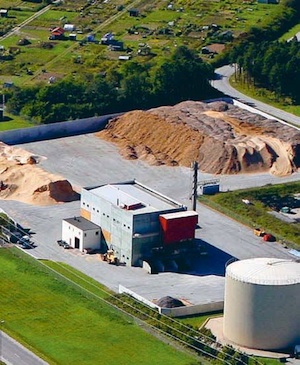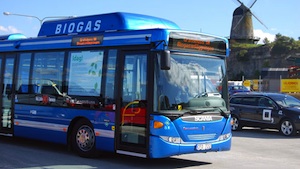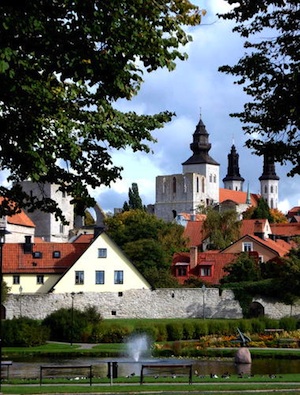Bio-fuelled district heating
A former Viking site on the island of Gotland, Visby was the main centre of the Hanseatic League in the Baltic from the 12th to the 14th century. Its 13th-century ramparts and more than 200 warehouses and wealthy merchants’ dwellings from the same period make it the best-preserved fortified commercial city in northern Europe.
Als Element bei der Konservierung von Visby Gebäude, Bau eines Fernwärmenetzes begannen einige 30 Jahren. Jetzt, alle Wärme in Visby Fernwärme erzeugt wird mit einer Mischung aus erneuerbaren Energien.
Visby’s district heating project is not an isolated case on an island where the use of renewable is guaranteed. Gotland is a showcase for a number of interesting and innovative renewable energy initiatives. This is not really surprising. Gotland has Sweden’s highest sunshine figures, enjoys good access to biofuels and is one of the best European locations for wind power. These natural assets, the entrepreneurship of the islanders and the municipality’s focus on strategic environmental planning have led to the realisation of many ideas for increasing the sustainability of Gotland’s local energy supply.
Biofuel in Visby Fernwärme
The World Heritage City of Visby consists of many unique buildings and mediaeval ruins that are built from limestone. Einige seiner ältesten Gebäude haben auch schön Portale und Friese in Gotland Sandstein gehauen. Beide Steine sind empfindlich gegenüber Luftschadstoffen und, insbesondere, Emissionen aus der Verbrennung von fossilen Brennstoffen.
In Visby als Ganzes, Fernwärme macht über 80 Prozent aller Erhitzen auf Geschäftsräume und Wohnungen versorgt. Zum Nutzen von Visby die Bewohner der Stadt und Erbe, Diese Erwärmung trägt zu einer nachhaltigen Gesellschaft.
Environmental benefits are evident, since fossil fuels have not been used in Visby’s district heating since 2006. Fernwärme beseitigt die Notwendigkeit für Kraftstoff Transport in den engen Gassen von Visby Innenstadt. Außerdem, the use of biofuels reduces the emission of sulphur and nitrogen oxides. Gegenüber der Verwendung von fossilen Brennstoffen, es senkt auch das Netz Zugabe von Kohlendioxid in die Atmosphäre.
Seit 1980, Schwefelemissionen aus Visby Fernwärme haben durch umgestürzte 95 Prozent. Im Vergleich mit einzelnen Heiz-, Fernwärme lässt die Luft sauberer und gesünder für Visby Bewohner und der Stadt empfindlich kulturellen Erbes.
Das Fernwärmenetz in Visby nimmt seine Wärme aus:
- Bark, Zweige, Zweige und andere (angeschlagen) Rückstände aus Rodungen und Sägewerke.
- Ein Meerwasser basierende Wärmepumpe mit einem 11 MW.
- Biogas aus dem jetzt geschlossenen Deponie in Visby.
- Biogas aus der Kläranlage.
- Bio-Öle, die fossile Öle ersetzen.
In addition to that, the municipality has set very high standards for energy efficiency and they have launched a new plan for the historic centre, where energy aspects are integrated with a general plan for building conservation.
Eco-Municipality of Gotland
Visby is the seat of Gotland Municipality, which took the view to become “an ecologically sustainable society within the course of a generation”. Many years ago, the Municipality of Gotland adopted a route which would lead away from fossil fuels and towards reduced climate impact. Heute, all electricity used in the municipality’s operations is certificated as Good Environmental Choice, which means that it is produced solely from renewable energy sources.
Gotland has implemented interesting reference projects in a wide range of experiences that include wind power, biogas, solar PV and sustainable architecture. The island has been a pioneer in promoting local ownership by wind co-operatives, where around 2000 households are involved.
Derzeit, one of the smartest electricity network in the world is currently under development on the island. This allows that by using modern technology, large quantities of renewable energy sources can be integrated in the grid.
Canada
Visby’s bio-fuelled district heating case shows the advantages of a smart alliance between renewable energy and heritage conservation, and can be taken as a model for many historic centres at those latitudes. This project is part of the common objective of achieving energy self-sufficiency from renewables by 2025, taking into account that the realisation of a Sustainable Energy System requires action at all levels of society.
The experience of Visby, and of Gotland in general, becomes more relevant if we take into account the geographical position of the island, in the middle of the Baltic Sea, that makes it a natural meeting place for cooperation between regions in the Baltic Sea Region.


















